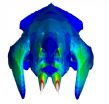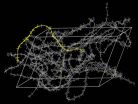(Press-News.org) Research from the University of Leeds and an international team of scientists has shown a recent increase in atmospheric hydrogen chloride (HCI), a substance linked to destruction of the ozone layer.
It was anticipated that there would be a decline in HCI under the Montreal Protocol, the international treaty designed to protect the ozone layer by phasing out the production of ozone-depleting substances.
Dr Emmanuel Mahieu from the University of Liège in Belgium, who led the research, explained: "It's important to say that the Montreal Protocol is still on track, and that this is a transient reversal in the decline of HCl, which can be explained through a change in atmospheric circulation, rather than rogue emissions of ozone-depleting substances."
The study, published today in the journal Nature, explains that the unexpected increase is caused by a temporary but prolonged anomaly in atmospheric circulation, changing the balance between chlorofluorocarbons (CFCs) and their breakdown product HCI.
Professor Martyn Chipperfield from the University of Leeds, who led the modelling work for the study, said: "The expected deterioration of ozone-destroying chemicals in the atmosphere is certainly more complex than we had imagined. Rather than a steady decline, these findings have presented a rather more complicated picture.
"Through comparison with detailed computer models, we have identified this decline as temporary due to changes in upper atmospheric wind patterns, so we remain optimistic that the ozone layer will recover during the second half of the century."
The recent increase in HCl concentrations was only observed in the Northern Hemisphere, whilst in the Southern Hemisphere, HCI continues to decrease, as expected, in line with the Montreal Protocol.
Professor Chipperfield added: "There are natural differences in the atmosphere between the Northern and Southern Hemispheres, due to the influence of the Earth's surface topography and slight variations in the Earth's orbit around the Sun during the year. While atmospheric chlorine levels remain high we may see cases of large ozone depletion, especially over the polar regions".
The findings are based on measurements by a network with stations in Spitsbergen, Greenland, Sweden, Switzerland, Japan, Tenerife, Australia and New Zealand. These are backed up by satellite observations and model simulations.
Professor Peter Bernath, from the University of York, who was also part of the international team of scientists, added: "Atmospheric variability and perhaps climate change can significantly modify the path towards full recovery and, ultimately, it will be a bumpy ride rather than a smooth evolution.
"The recovery of ozone-depleting chemicals in the atmosphere is a slow process and will take many decades. During this time the ozone layer remains vulnerable."
INFORMATION:
The research was led by the University of Liège, Belgium, and involved scientists from Australia, Canada, Germany, Japan, New Zealand, the UK, and the USA.
Notes to editors:
Professor Martyn Chipperfield is available for interview. Please contact Sarah Reed, Press Officer at the University of Leeds, on +44 (0)113 34 34196 or email s.j.reed@leeds.ac.uk.
The paper, 'Recent Northern Hemisphere stratospheric HCl increase due to atmospheric circulation changes' is published in Nature on 6 November 2014: http://dx.doi.org/10.1038/nature13857
The first fossil of an amphibious ichthyosaur has been discovered in China by a team led by researchers at the University of California, Davis. The discovery is the first to link the dolphin-like ichthyosaur to its terrestrial ancestors, filling a gap in the fossil record. The fossil is described in a paper published in advance online Nov. 5 in the journal Nature.
The fossil represents a missing stage in the evolution of ichthyosaurs, marine reptiles from the Age of Dinosaurs about 250 million years ago. Until now, there were no fossils marking their transition from land ...
Many fire scientists have tried to get Smokey the Bear to hang up his "prevention" motto in favor of tools like thinning and prescribed burns, which can manage the severity of wildfires while allowing them to play their natural role in certain ecosystems.
But a new international research review led by the University of California, Berkeley, says the debate over fuel-reduction techniques is only a small part of a much larger fire problem that will make society increasingly vulnerable to catastrophic losses unless it changes its fundamental approach from fighting fire ...
BOSTON – Each year nearly two million Americans suffer osteoporosis-related fractures, and as the population ages that number is expected to increase dramatically, placing a major burden on the health care system. While osteoporosis prevention and treatment efforts have historically been focused on post-menopausal women, a new study from Beth Israel Deaconess Medical Center (BIDMC) suggests that critical opportunities are being lost by not focusing more attention on bone loss and fracture risk in older men.
"Given that the prevalence of fragility fractures among ...
When it comes to genitalia, nature enjoys variety. Snakes and lizards have two. Birds and people have one. And while the former group's paired structures are located somewhat at the level of the limbs, ours, and the birds', appear a bit further down. In fact, snake and lizard genitalia are derived from tissue that gives rise to hind legs, while mammalian genitalia are derived from the tail bud. But despite such noteworthy contrasts, these structures are functionally analogous and express similar genes.
How do these equivalent structures arise from different starting ...
Scientists from the Department of Energy's SLAC National Accelerator Laboratory and the University of California, Los Angeles have shown that a promising technique for accelerating electrons on waves of plasma is efficient enough to power a new generation of shorter, more economical accelerators. This could greatly expand their use in areas such as medicine, national security, industry and high-energy physics research.
This achievement is a milestone in demonstrating the practicality of plasma wakefield acceleration, a technique in which electrons gain energy by essentially ...
AMHERST, Mass. – The surprise discovery of the fossilized skull of a 66- to 70-million-year-old, groundhog-like creature on Madagascar has led to new analyses of the lifestyle of the largest known mammal of its time by a team of specialists including biologist Elizabeth Dumont at the University of Massachusetts Amherst, an expert in jaw structure and bite mechanics.
The skull of this animal, named Vintana sertichi, was found in a geological formation deposited when a great variety of dinosaurs roamed the earth. With a skull that is almost five inches (125 mm) ...
A new study led by the University of California, Berkeley and involving the University of Colorado Boulder indicates the current response to wildfires around the world—aggressively fighting them—is not making society less vulnerable to such events.
The study suggests the key is to treat fires like other natural hazards—including earthquakes, severe storms and flooding—by learning to coexist, adapt and identify vulnerabilities. The new study indicates government-sponsored firefighting and land management policies may actually encourage development ...
Australian researchers have shown why calcium-binding drugs commonly used to treat people with osteoporosis, or with late-stage cancers that have spread to bone, may also benefit patients with tumours outside the skeleton, including breast cancer.
Several clinical trials – where women with breast cancer were given these drugs (bisphosphonates) alongside normal treatment for early-stage disease – showed that they can confer a 'survival advantage' and inhibit cancer spread in some women, although until now no-one has understood why.
A new study by Professor ...
Researchers from the University of Cambridge have identified a class of low-cost, easily-processed semiconducting polymers which, despite their seemingly disorganised internal structure, can transport electrons as efficiently as expensive crystalline inorganic semiconductors.
In this new polymer, about 70% of the electrons are free to travel, whereas in conventional polymers that number can be less than 50%. The materials approach intrinsic disorder-free limits, which would enable faster, more efficient flexible electronics and displays. The results are published today ...
CHICAGO (November 5, 2014) – When wildfire and people intersect, it is often in the wildland-urban interface, or WUI, a geography where homes, roads and trails intermix with fire-prone vegetation. In an article published Thursday in the journal Nature, U.S. Forest Service scientist Sarah McCaffrey and her colleagues advocate for an approach to wildfire management that reflects ecological science as well as research on the human dimensions of wildfire and fire management.
"Learning to Coexist with Wildfire," a research review led by the University of California-Berkley, ...





